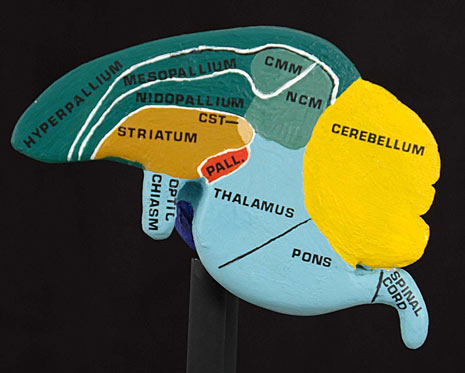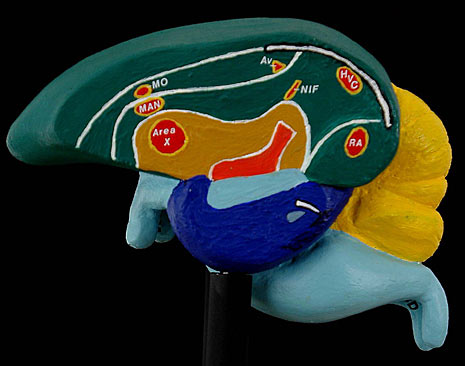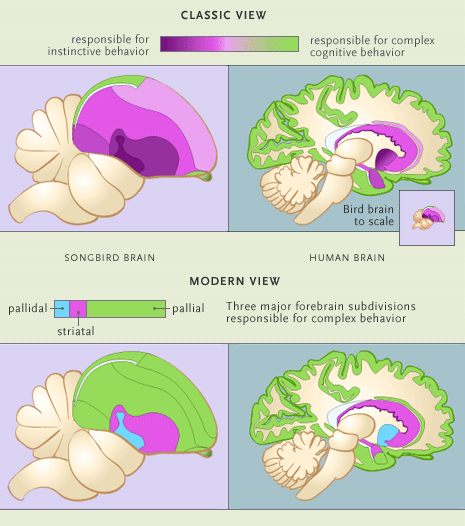

|
In the past few decades, scientists have learned that the basis of everything they thought they knew about bird brains—that they were largely comprised of the most primitive and instinctual of brain structures—was wrong. Fully 75 percent of the brains of parrots, hummingbirds, and thousands of other species of songbirds is actually made up of a sophisticated information processing system that works much the same way as the locus of human higher-mindedness, the cerebral cortex. Below, take a look at a songbird brain model the way Erich Jarvis and other neurobiologists now see it.—Lexi Krock
Colored green above, a songbird's cortex, which dominates the bird brain anatomy, functions similarly to a human cortex. It is the outer brain shell responsible for controlling perception and some aspects of complex behavior. Scientists used to think songbirds had only a very thin and small cortex. Indeed, they believed that nearly the entire green region you see here controlled only instinctual behavior. Thus, the bird's brain was thought to be nearly all instinct driven. The dark and light blue regions seen on the model constitute the brainstem, which sit toward the back of a bird's neck and regulate unconscious behaviors. They also serve as relay stations to the cerebral regions (green, and brown and orange, seen in the images below). The darker blue area is called the midbrain. It is a processing station between the thalamus (lighter blue), which collects and distributes sensory information, and the cerebrum, responsible for higher brain functions such as vocal syntax. The midbrain also transmits information between the thalamus and the spinal cord. The yellow area is the cerebellum, which regulates fine movement controls. 
The orange and brown regions you see in this view (above) of the brain cut in half lengthwise are comparable to the basal ganglia in humans, which, along with the cortex, control the learning and sequencing of movements. Previously, scientists believed that the somewhat primitive operations of this small region of the brain extended throughout the green area of the brain. Erich Jarvis believes that birds' basal ganglia are also involved in memory and general learning, and suggests that at some point soon these functions will be added to the widely accepted view of their function. 
The seven red circles are clusters of neurons. Seen in this view of the brain with about one quarter removed lengthwise, they control the learning (three in the front) and production (four in the back) of vocalizations. These seven neuron clusters are similar among birds that are "vocal learners"—songbirds, parrots, and hummingbirds—and may have some similarities with neuronal language pathways in humans, Erich Jarvis proposes. Surprisingly, some birds such as parrots can teach and learn hundreds or even thousands of different calls, the basic communication skill that makes human language possible. So-called vocal learning is a kind of intelligence not found in any mammal other than people, bats, dolphins, whales, and elephants. Even chimpanzees and other primates closely related to humans are not as vocally sophisticated as birds. 
This diagram compares the classic view of a bird brain as defined by German naturalist Ludwig Edinger, who did the first studies of bird brain anatomy in the 19th century, to the current view of the bird brain. Both views are also set against views of the human brain then and now. Edinger's vision of a bird's neuroanatomy was widely held until about 30 years ago. Studies of brain chemicals and neural connections have shown that most of a bird's small brain (notice it shown to scale) consists of a robust "pallium," or higher-processing center. In fact, many birds have more powerful palliums than mammals.
To learn more about the specific bird neuroanatomy in all the images above and
how Erich Jarvis and others recently redefined the bird brain with new
nomenclature, visit the Avian Brain Nomenclature Exchange
online.
Photos: (bird brain model and QuickTime VR) © NOVA/WGBH Educational Foundation; (bird brain diagram) Courtesy Erich Jarvis/AvianBrain.org |
|||||||||||
|
|
|||||||||||
|
© | Created October 2005 |
|||||||||||